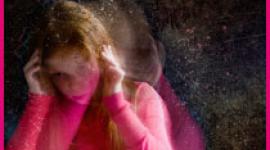Coping with Night Terrors
Difference between night terror and nightmare explained. What causes a child to have night terrors and how parents can help.
It's 10 p.m. As your head hits the pillow, a blood-curdling scream from your toddler's bedroom propels you like a shot down the hallway. You find her sitting up in bed. Wide-eyed, she's screaming and flailing her arms. It's one of the scariest things you've ever seen. As you rush to her, you see she doesn't appear hurt or sick. It must be a nightmare, you think. "I'm here," you say as you put your arms around her wriggling body. But the more you try to calm her, the more upset she gets.
What's going on?
Most likely, your child is having a night terror - a relatively common occurrence that appears mostly in young children, typically between the ages of 3 to 5 years. Two to 3% of all children will experience episodes of night terrors. By the time they reach school age, most of these children will have outgrown these generally harmless events.
"It's frightening but is not unusual or dangerous to a child," says Harry Abram, MD, a pediatric neurologist. "As the brain matures and a child's sleep pattern matures, the terrors go away."
Night Terror or Nightmare?
 A night terror is not the same thing as a nightmare. Nightmares occur during the dream phase of sleep known as REM sleep (this stands for Rapid Eye Movement; also known as "dreaming" sleep). The circumstances of the nightmare will frighten the child, who usually will wake up with a vivid memory of a long movie-like dream. Night terrors, on the other hand, occur during a phase of deep non-REM sleep - usually an hour or two after the child goes to bed. During a night terror, which may last anywhere from a few minutes up to an hour, the child is still asleep. Her eyes may be open, but she is not awake. When she does wake up, she'll have absolutely no recollection of the episode other than a sense of fear.
A night terror is not the same thing as a nightmare. Nightmares occur during the dream phase of sleep known as REM sleep (this stands for Rapid Eye Movement; also known as "dreaming" sleep). The circumstances of the nightmare will frighten the child, who usually will wake up with a vivid memory of a long movie-like dream. Night terrors, on the other hand, occur during a phase of deep non-REM sleep - usually an hour or two after the child goes to bed. During a night terror, which may last anywhere from a few minutes up to an hour, the child is still asleep. Her eyes may be open, but she is not awake. When she does wake up, she'll have absolutely no recollection of the episode other than a sense of fear.
Why Does My Child Have Night Terrors?
Several factors may contribute to your child's night terrors. It's likely that if you or your spouse had night terrors, your child will, too. Fatigue and psychological stress may also play roles in their occurrence. Make sure your child is getting plenty of rest. Be aware of things that may be upsetting to your child, and to the extent you are able, try to minimize the distress.
Children usually have night terrors at the same time each night, generally sometime in the first few hours after falling asleep. Doctors suggest you wake your child about 30 minutes before the night terror usually happens. Get your child out of bed, and have her talk to you. Keep her awake for 5 minutes, and then let her go back to sleep.
Night terrors can be a frightening phenomenon of childhood but they are not dangerous. If they occur frequently or over a long period of time, however, discuss this with your child's doctor.
What Can I Do?
It's helpful to know that although these events may be disturbing for you, night terrors themselves are not harmful to your child. But because a child may get out of bed and run around the room, doctors do advise parents to gently restrain a child experiencing night terrors. Otherwise, let the episode run its course. Shouting and shaking your child awake will just agitate her more. Remember to warn babysitters and other family members who may be present overnight so that they will understand what is happening and won't overreact.
next: Drugs and Medical Conditions Contributing to Inaccurate Evaluation of Anxiety Disorders
~ anxiety-panic library articles
~ all anxiety disorders articles
APA Reference
Gluck, S.
(2007, February 18). Coping with Night Terrors, HealthyPlace. Retrieved
on 2025, December 22 from https://www.healthyplace.com/anxiety-panic/articles/coping-with-night-terrors



